Ireland is rightly proud of its whiskey making heritage and in Bushmills Distillery, County Antrim, it claims to have the world’s oldest licensed whiskey distillery, first mentioned in records dating back to 1608.
There are a few techniques that Irish distillers have adopted over the years that help make much of the country's whiskey have its own unique style. These include the use of unmalted barley, copper pot stills and triple distillation.
Ireland’s classic style is single pot still whiskey. Much like single malt whiskey, ‘single’ means that the whiskey is distilled at one distillery. But whereas single malt uses 100% malted barley, single Irish pot still whiskey includes unmalted barley in the mix and produces whiskey with a uniquely fresh, tangy spiciness to it.
You may also hear it referred to as ‘pure’ Irish whiskey, although this term has now been banned on labels for over a decade.
In order to be labelled as a whiskey, the spirit needs to spend a minimum of three years in wooden barrels. As with other regions, distillers can alter the flavour profile of their whiskey by ageing it in various casks.
The most common of these is ex-bourbon, which lends sweet vanilla flavours to the whiskey, but you’ll also find sherry casks regularly used along with an increasing number of more unusual barrels as producers look to satisfy more adventurous drinkers.
Unusually among the leading whiskey producing countries, other woods apart from oak are also permitted, although straying from the oak standard is very much a rare practice.
In this piece we’ll introduce you to some fantastic pot still Irish whiskey, along with some of the country’s famous blends and a few other whiskeys that are more experimental in nature. Many of these offer great value for the whiskey drinker which, besides the undoubted range and quality of their output. Another great reason to develop a taste for this whiskey-loving nation’s wares.
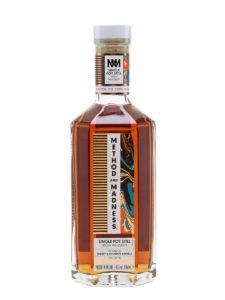
Best single pot still Irish whiskey
5/5
Tasting notes: Prickly spice, stewed apples and tannic wood
Ever found yourself wanting a drink but being in a not-quite-with-it mood that makes you indecisive in deciding exactly what you want? When this happens to us, we often reach for a bottle of Method and Madness Single Pot Still whiskey. It’s the kind of whiskey that is so alive with interesting flavour that it quickly brings us to our senses and kick starts the evening in style.
The unique twist to this Irish whiskey is in the finishing: French Chestnut casks. Give it a taste and your mouth will be greeted with prickles of spice, waking you up and opening your senses to the other flavours contained within. Stewed apples and boozy raisins are at the heart of its fruity characters, while tannic wood flavours emerge at the finish, forcing your cheeks into producing an even wider grin. Sometimes this whiskey tastes so good, we’ve been known to declare it the best drink ever.
BUY HERE Method and Madness Single Pot Still, 46%

Best for a grain whiskey
4/5
Tasting notes: Smooth, sweet corn spiced up with tannic red wine and grapes
You can explore a wide range of Irish whiskey styles with Teeling – the popular Dublin based producer has an innovative streak that sees them toying with various whiskey making methods and ingredients. One of their more unusual successes is this Single Grain whiskey, made with 95% corn and 5% malted barley and aged in ex-cabernet sauvignon wine casks (‘single grain’ means it has been made at a single distillery).
The whiskey is very much a sum of its parts, from the pinkish hue courtesy of the red wine to a sweet flavour that is very typical of corn whiskeys. An initial smoothness is quickly punctuated by some sharp blackberry and spice, with the wine’s tannins and the oak ageing adding some heat and a rapidly drying finish. This whiskey is an innovation that has paid off and, besides enjoying its unique flavours on its own, we think would contribute to a fantastically Irish Old Fashioned.
BUY HERE Teeling Single Grain Irish Whiskey, 46%
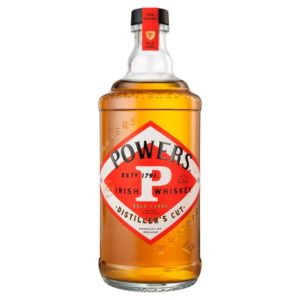
Best Irish blended whiskey
4/5
Tasting notes: Cinnamon, pepper and charred oak
Ireland is home to numerous well known blends, many of which offer great value for the whiskey drinker. Powers Gold Label is one such whiskey, readily available for less than £30, and a consistent award winner, even when pitted against more expensive bottles.
It’s a blend of pot still and grain whiskeys, and you get a good taste of typical Irish spice from the former, tingling with cinnamon, oak and pepper. Some toasty charred notes give it depth along with a lingering finish, and it has a smooth, almost oily feel that helps it to slip down with ease. It’s the kind of whisky that suits any occasion, whether you’re after quick pick me up, a winter warmer or something to pep up a whiskey based cocktail.
BUY HERE Powers Gold Label, 40%
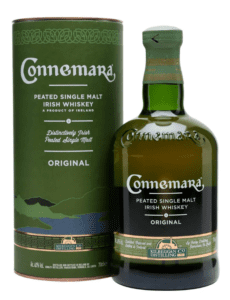
Best Peated Irish Whiskey
Tasting notes: Fresh, green apples and grass with subtle smoke
4/5
Peated whiskey isn’t as popular in Ireland as it is in Scotland and you won’t find many distilleries selling it within their core range. An exception is Connemara, part of the Cooley distillery whose whisky also includes Kilbeggan.
Although obviously peaty, this whisky doesn’t send a blast of smoke through your senses in the way more heavily peated Scotch whiskies might. As a whole the whisky is light and fresh tasting, and makes us think of fruits the colour of their distinctive green label – sweet apples and grapes – along with some fresh green leafy herbs and grass. The smoke goes along with this light vibe, leaving you with subtle smoky flavour without the feeling you’ve been sat too close to an open fire all evening.
BUY HERE Connemara Peated Single Malt Whiskey, 40%

Best for an experimental Irish whiskey
Tasting notes: Spices, sweet pastries and lots of wood
4.5/5
Kinahan’s have taken full advantage of Irish Whiskey lawmakers allowing various woods to be used for the ageing process by building their own unique casks made from five different woods. The results are a complex medley of flavours, most of which are hard to pinpoint and provide a twist on the usual whiskey taste profile.
Before we play ‘guess the flavour’, here’s a list of the wood involved: we have the commonly used French and American oaks; the much more unusual Portuguese and Hungarian Oaks; and the some chestnut for good measure. As to the flavours, the last time we sipped it we think we detected spicey notes of cinnamon, nutmeg and something akin to incense; sweeter flavours of pastries, chocolate and cooked pineapple rings; and lots of wood. Polished wood, wood shavings, wet wood and charred wood. But as enjoyable as such guessing games can be, the key thing is that the overall taste is top quality.
BUY HERE Kinahan’s The Kasc Project, 43%
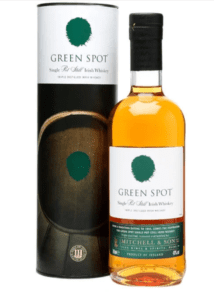
Best Single Pot Irish whiskey under £50
5/5
Tasting notes: Tangy spice, juicy apple, soft toffee
Green Spot whiskey used to be a secret that Dubliners kept to themselves, but now it’s travelled well beyond Ireland to worldwide acclaim. Made at the Midleton distillery, Green Spot is the oldest name in pot still whiskey, distilled in copper from a mix of malted and unmalted barley.
You should be pleased to hear that such a well loved classic is readily available for under £50, highlighting how much value there is in Irish whiskey. Toast your bargain-buying prowess by filling a glass and enjoy the pot still’s tangy spices, juicy apple and soft toffee flavours. You might even detect some tropical fruits too. A superb whiskey.
+++++

Best for an aged single pot still Irish whiskey
£220
Tasting notes: Mellow spices and rich fruits
5/5
Redbreast produces one of the best ranges of whiskey anywhere in the world, and if you’re looking to see what age does to a spirit, then their older releases are more affordable than most. Redbreast 12 is a multi award winner at around £50; their 15 year old is considered one of the best allround for value at under £90; and for less than £250 you can experience 21 years of ageing excellence.
It’s a Single Pot Still whiskey that has been matured in bourbon and sherry barrels, and those years have extracted all manner of complex flavours from the oak. It’s smooth, luscious and warming, with mellow spices and rich fruits adding huge depth to the barley flavours. And the finish lasts an age, with flavours of oak and spice constantly evolving on the palate. Sip slowly and appreciate the good work time does to a whiskey.
BUY HERE Redbreast 21 Year Old, 46%
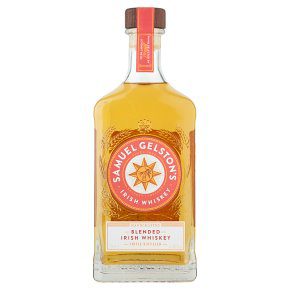
Best Single Malt Irish whiskey on a budget
4/5
Tasting notes: Caramel, toasted nuts and dancing oaky spice
The story of Samuel Gelston’s whiskey begins in Belfast in the 1830s. The business was purchased by Harry Neill in 1869 and has recently undergone a revival with Harry’s great, great grandson, Johnny Neill at the helm. With all that history and the family’s whiskey making expertise behind it, you might think a bottle would set you back a fair bit. But you could not be more wrong.
Despite its low price this is a well crafted whiskey, which is enjoyable as a neat sipper. It’s a sweet, caramel coated type of whiskey with a satisfying warmth of toasted nuts, cinnamon and the kind of oaky spices that dance around on your tongue for a while. A whisky that could accompany you through an evening of chat before sending you home with a rosy Irish glow to your cheeks.
BUY HERE Samuel Gelston’s Blended Irish Whiskey
Best whisky glasses: from crystal to tumblers, budget to Glencairn, from Amazon to ASDA
9 of the best Scottish whiskies: our favourite Scotch brands
Best Islay whisky: from Ardbeg to Laphroaig, the Islay whiskies you need to try
Best rye whiskey: ideal rye for a Sazerac, Manhattan, or simply neat
Best peated whisky: from Speyside to Islay, the peaty whiskies to please
8 of the best single malt whiskies
Best expensive whiskies worth the price tag: Macallan, Glengoyne, Tobermory, Glenfiddich
Best supermarket whiskies: best whisky buys from Lidl, Aldi, Morrisons and Tescos
Best blended whiskies: is it worth buying blended whisky? The best brands
Best world whiskies: from cheap to expensive, the world whisky brands you have to try
Best Irish whiskey: from cheap to expensive, single malt, blends, and smoky
Best Speyside whiskies: from single malt to blended, M&S to Glenfiddich
Best English whiskies: the English whisky brands worth buying
Best Japanese whisky: our expert guide to best brands, from single malt, blended, under £50, to best-selling
This article contains affiliate links. We may earn a commission on items purchased through this article, but this does not affect our editorial judgement